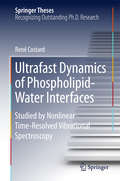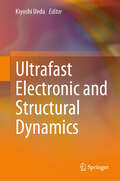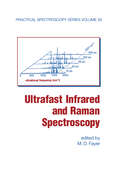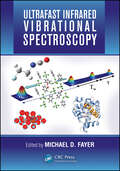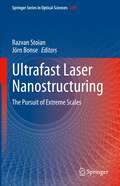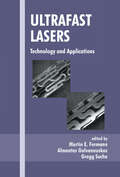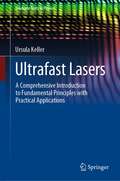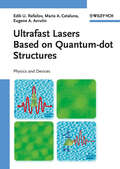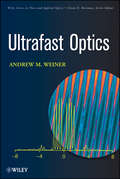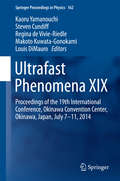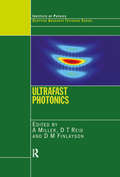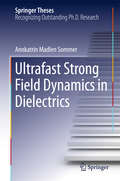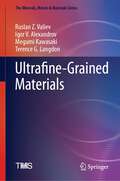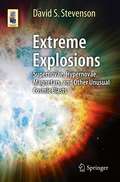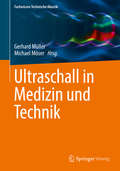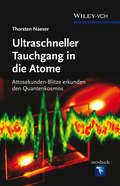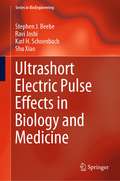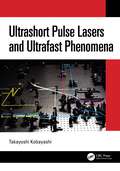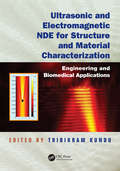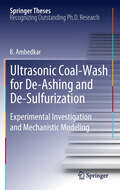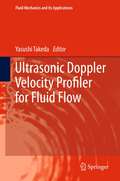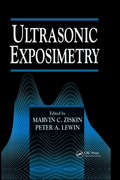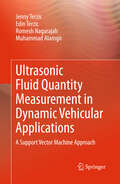- Table View
- List View
Ultrafast Dynamics of Phospholipid-Water Interfaces
by René CostardThis thesis presents a highly innovative study of the ultrafast structural and vibrational dynamics of hydrated phospholipids, the basic constituents of cell membranes. As a novel approach to the water-phospholipid interface, the author studies phosphate vibrations using the most advanced methods of nonlinear vibrational spectroscopy, including femtosecond two-dimensional infrared spectroscopy. He shows for the first time that the structure of interfacial water undergoes very limited fluctuations on a 300 fs time scale and that the lifetimes of hydrogen bonds with the phospholipid are typically longer than 10 ps. Such properties originate from the steric hindrance of water fluctuations at the interface and the orienting action of strong electric fields from the phospholipid head group dipoles. In an extensive series of additional experiments, the vibrational lifetimes of the different vibrations and the processes of energy dissipation are elucidated in detail.
Ultrafast Electronic and Structural Dynamics
by Kiyoshi UedaThis book illustrates advanced technologies for imaging electrons and atoms in action in various forms of matter, from atoms and diatoms to protein molecules and condensed matter. The technologies that are described employ ultrafast pulsed lasers, X-ray free electron lasers, and pulsed electron guns, with pulse durations from femtoseconds, suitable to visualize atoms in action, to attoseconds, needed to visualize ballistic electron motion. Advanced theories, indispensable for understanding such ultrafast imaging and spectroscopy data on electrons and atoms in action, are also described. The book consists of three parts. The first part describes probing methods of attosecond electron dynamics in atoms, molecules, liquids, and solids. The second part describes femtosecond structural dynamics and coupling of structural change and electron motion in molecules and solids The last part is dedicated to ultrafast photophysical processes and chemical reactions of protein molecules responsible for biological functions.
Ultrafast Infrared And Raman Spectroscopy
by M.D. FayerA description of procedures for probing bond activation, H-bonded systems, molecular dynamical mechanisms, vibrational dephasing, simple liquids, and proteins and energy flow effects using ultrafast vibrational spectroscopy experiments. It discusses experimental and theoretical methods of ultrafast infrared and Raman measurements.
Ultrafast Infrared Vibrational Spectroscopy
by Michael D. FayerThe advent of laser-based sources of ultrafast infrared pulses has extended the study of very fast molecular dynamics to the observation of processes manifested through their effects on the vibrations of molecules. In addition, non-linear infrared spectroscopic techniques make it possible to examine intra- and intermolecular interactions and how su
Ultrafast Laser Nanostructuring: The Pursuit of Extreme Scales (Springer Series in Optical Sciences #239)
by Razvan Stoian Jörn BonseBringing together contributions from leading experts in the field, this book reviews laser processing concepts that allow the structuring of material beyond optical limits, and methods that facilitate direct observation of the underlying mechanisms by exploring direct structuring and self-organization phenomena. The capacity to nanostructure material using ultrafast lasers lays the groundwork for the next generation of flexible and precise material processing tools. Rapid access to scales of 100 nm and below in two and three dimensions becomes a factor of paramount importance to engineer materials and to design innovative functions. To reflect the dynamic nature of the field at all levels from basic science to applications, the book is divided into three parts, Fundamental Processes, Concepts of Extreme Nanostructuring, and Applications, each of which is comprehensively covered. This book will be a useful resource for graduate students and researchers in laser processing, materials engineering, and nanoscience.
Ultrafast Lasers: Technology and Applications
by Martin E. Fermann Almantas Galvanauskas Gregg SuchaCovering high-energy ultrafast amplifiers and solid-state, fiber, and diode lasers, this reference examines recent developments in high-speed laser technology. It presents a comprehensive survey of ultrafast laser technology, its applications, and future trends in various scientific and industrial areas. Topics include: micromachining applications
Ultrafast Lasers: A Comprehensive Introduction to Fundamental Principles with Practical Applications (Graduate Texts in Physics)
by Ursula KellerThis textbook presents a comprehensive introduction to ultrafast laser physics with a keen awareness of the needs of graduate students. It is self-contained and ready to use for both ultrafast laser courses and background for experimental investigation in the lab. The book starts with an advanced introduction to linear and nonlinear pulse propagation, details Q-switching and modelocking and goes into detail while explaining ultrashort pulse generation and measurement. Finally, the characterization of the laser signals is illustrated, and a broad range of applications presented. A multitude of worked examples and problems with solutions help to deepen the reader's understanding.
Ultrafast Lasers Based on Quantum Dot Structures: Physics and Devices
by Edik U. Rafailov Maria Ana Cataluna Eugene A. AvrutinIn this monograph, the authors address the physics and engineering together with the latest achievements of efficient and compact ultrafast lasers based on novel quantum-dot structures and devices. Their approach encompasses a broad range of laser systems, while taking into consideration not only the physical and experimental aspects but also the much needed modeling tools, thus providing a holistic understanding of this hot topic.
Ultrafast Optics
by Andrew WeinerA comprehensive treatment of ultrafast opticsThis book fills the need for a thorough and detailed account of ultrafast optics. Written by one of the most preeminent researchers in the field, it sheds new light on technology that has already had a revolutionary impact on precision frequency metrology, high-speed electrical testing, biomedical imaging, and in revealing the initial steps in chemical reactions.Ultrafast Optics begins with a summary of ultrashort laser pulses and their practical applications in a range of real-world settings. Next, it reviews important background material, including an introduction to Fourier series and Fourier transforms, and goes on to cover:Principles of mode-lockingUltrafast pulse measurement methodsDispersion and dispersion compensationUltrafast nonlinear optics: second orderUltrafast nonlinear optics: third orderMode-locking: selected advanced topicsManipulation of ultrashort pulsesUltrafast time-resolved spectroscopyTerahertz time-domain electromagneticsProfessor Weiner's expertise and cutting-edge research result in a book that is destined to become a seminal text for engineers, researchers, and graduate students alike.
Ultrafast Phenomena in Molecular Sciences
by Rebeca Nalda Luis BañaresThis book presents the latest developments in Femtosecond Chemistry and Physics for the study of ultrafast photo-induced molecular processes. Molecular systems, from the simplest H2 molecule to polymers or biological macromolecules, constitute central objects of interest for Physics, Chemistry and Biology, and despite the broad range of phenomena that they exhibit, they share some common behaviors. One of the most significant of those is that many of the processes involving chemical transformation (nuclear reorganization, bond breaking, bond making) take place in an extraordinarily short time, in or around the femtosecond temporal scale (1 fs = 10-15 s). A number of experimental approaches - very particularly the developments in the generation and manipulation of ultrashort laser pulses - coupled with theoretical progress, provide the ultrafast scientist with powerful tools to understand matter and its interaction with light, at this spatial and temporal scale. This book is an attempt to reunite some of the state-of-the-art research that is being carried out in the field of ultrafast molecular science, from theoretical developments, through new phenomena induced by intense laser fields, to the latest techniques applied to the study of molecular dynamics.
Ultrafast Phenomena XIX
by Kaoru Yamanouchi Steven Cundiff Regina Vivie-Riedle Makoto Kuwata-Gonokami Louis DimauroThis book presents the latest advances in ultrafast science, including both ultrafast optical technology and the study of ultrafast phenomena. It covers picosecond, femtosecond, and attosecond processes relevant to applications in physics, chemistry, biology, and engineering. Ultrafast technology has a profound impact in a wide range of applications, amongst them biomedical imaging, chemical dynamics, frequency standards, material processing, and ultrahigh-speed communications. This book summarizes the results presented at the 19th International Conference on Ultrafast Phenomena and provides an up-to-date view of this important and rapidly advancing field.
Ultrafast Photonics (Scottish Graduate Series)
by A. Miller D. T. Reid D. M. FinlaysonUltrafast photonics has become an interdisciplinary topic of high international research interest because of the spectacular development of compact and efficient lasers producing optical pulses with durations in the femtosecond time domain. Present day long-haul telecommunications systems are almost entirely based on the transmission of short burst
Ultrafast Strong Field Dynamics in Dielectrics
by Annkatrin Madlen SommerThis thesis presents a systematic discussion of experimental approaches to investigating the nonlinear interaction of ultrashort visible strong fields with dielectrics directly in the time domain. The key finding is the distinctly different peak-intensity dependence of the light-matter energy transfer dynamics on the one hand, and the observed transient optical and electronic modifications on the other. As the induced electron dynamics evolve on sub-femtosecond timescales, real-time spectroscopy requires attosecond temporal resolution. This allows a range of parameters to be identified where the optical properties of the samples exposed to ultrashort light fields suffer dramatic changes allowing signal metrology while real absorption leading to dissipation is essentially absent. These findings indicate the feasibility of efficient optical switching at frequencies several orders of magnitude faster than current state-of-the-art electronics and thus have far-reaching technological consequences.
Ultrafiltration and Microfiltration Handbook
by Munir CheryanSoon after its publication in 1987, the first edition of Ultrafiltration Handbook became recognized as the leading handbook on ultrafiltration technology. Reviews in professional journals praised it as an authoritative and substantive information resource on this technology. Now a completely, updated and expanded edition is available under the titl
Ultrafine-Grained Materials (The Minerals, Metals & Materials Series)
by Ruslan Z. Valiev Igor V. Alexandrov Megumi Kawasaki Terence G. LangdonThis book summarizes and provides a detailed overview of the enhanced mechanical and functional properties of bulk nanostructured metallic materials with respect to their potential applications. These applications include nanostructured Ti-based materials in bio-medical engineering, Al alloys and Cu in electrical engineering and nanostructured steels in construction engineering. Moreover, this book describes the application of severe plastic deformation for the formation of hybrid metal systems from simple powders and solid metals for an enhancement in the functional properties of materials. Authored by global leaders in the field, this book will serve as a bridge between researchers and professionals engineering the newest nanomaterials.
Ultranovae!: Blasts from the Frontier of Astronomy
by David S. Stevenson'Supernovae!: Blasts from the Frontier of Astronomy' examines the most recent and exciting discoveries about what happens at the end of the stellar evolution of a massive stars. This book focuses on the extreme - the most intense and brilliant of astronomical explosions. It features the discoveries of SN 2007bi, a pair-instability supernova and SN 2006gy, a pulsational-pair instability supernova, or hypernova. These are highly significant observational finds that push the frontiers of astronomy and astrophysics, particularly as these objects were hitherto only predicted in theory and previously thought to be relics of the early universe, hence unobservable now. 'Supernovae!' examines and explains cataclysmic and unusual events at the very frontier of our knowledge of stellar astrophysics, and presents them in a way that non-professionals can understand and enjoy.
Ultraschall in Medizin und Technik (Fachwissen Technische Akustik)
by Michael Möser Gerhard MüllerDieser Band der Reihe Fachwissen Technische Akustik erläutert die technischen Grundlagen und Besonderheiten des Ultraschalls. Der Autor befasst sich mit der Erzeugung und Messung von Ultraschall und den Eigenschaften des Schallfeldes. In einem zweiten Teil werden einige wichtige Anwendungen von Ultraschall in Medizin und Technik dargestellt.
Ultraschneller Tauchgang in die Atome
by Thorsten NaeserDie Welt der Moleküle Atome und Elektronen strapaziert unsere Vorstellungskraft von Zeit. In Millionsteln einer milliardstel Sekunde finden chemische Reaktionen statt. Noch tausend Mal schneller, in Attosekunden, wechseln quantenmechanisch Elektronen ihren Aufenthaltsort in Atomen. Wer diese Elementarteilchen >fotografierenEr erzählt die Geschichte der Ultrakurzzeitphotographie, der Quantenmechanik und schließlich der auf modernster Lasertechnologie basierenden Attosekundenphysik. Schnell wird klar: Die Jagd nach immer kürzeren ?Belichtungszeiten?, noch winzigeren Sekundenbruchteilen und spektakulären Bildern aus dem Mikrokosmos ist in vollem Gang.
Ultrashort Electric Pulse Effects in Biology and Medicine (Series in BioEngineering)
by Stephen J. Beebe Ravi Joshi Karl H. Schoenbach Shu XiaoThis book presents an overview of the current state of research on ultrashort electric field pulses of high intensity and their use in biology and medicine. It examines in detail the most recent and exciting advances in how nanosecond and picosecond electric pulse research has grown and expanded into new areas of biology and medicine. Further, the book specifically focuses on electric pulses in the time domain, on intracellular effects as opposed to plasma membrane electroporation, and highlights the biological and medical applications of these unique pulse effects. Since the authors were initial innovators exploring nanosecond and picosecond pulses, their unique perspectives foreshadowed directions the research took, expanding into new areas that they continue to investigate today.
Ultrashort Pulse Lasers and Ultrafast Phenomena
by Takayoshi KobayashiThis book describes the basic physical principles of techniques to generate and ultrashort pulse lasers and applications to ultrafast spectroscopy of various materials covering chemical molecular compounds, solid-state materials, exotic novel materials including topological materials, biological molecules and bio- and synthetic polymers. It introduces non-linear optics which provides the basics of generation and measurement of pulses and application examples of ultrafast spectroscopy to solid state physics. Also it provide not only material properties but also material processing procedures. The book describes also details of the world shortest visible laser and DUV lasers developed by the author’s group. It is composed of the following 12 Sections: The special features of this book is that it is written by a single author with a few collaborators in a systematic way. Hence it provides a comprehensive and systematic description of the research field of ultrashort pulse lasers and ultrafast spectroscopy. Generation of ultrashort pulses in deep ultraviolet to near infrared Generation of ultrashort pulses in terahertz Carrier envelope phase (CEP) Simple NLO processes with a few colors Multi-color involved NLO processes Multi-color ultrashort pulse generation NLO materials NLO processes in time-resolved spectroscopy Low dimension materials Conductors and superconductors Chemical reactions and material processing Photobiological reactions
Ultrasonic and Electromagnetic NDE for Structure and Material Characterization: Engineering and Biomedical Applications
by Tribikram KunduMost books on nondestructive evaluation (NDE) focus either on the theoretical background or on advanced applications. Bridging the gap between the two, Ultrasonic and Electromagnetic NDE for Structure and Material Characterization: Engineering and Biomedical Applications brings together the principles, equations, and applications of ultrasonic and
Ultrasonic Coal-Wash for De-Ashing and De-Sulfurization
by B. AmbedkarThis study focuses on the physical aspects of ultrasonic de-ashing and de-sulfurization, such as cavitation, streaming and their combined effects. Ambedkar Balraj proposes an ultrasound-assisted coal particle breakage mechanism and explores aqueous and solvent-based ultrasonic techniques for de-ashing and de-sulfurization. Ambedkar designs a Taguchi L-27 fractional-factorial matrix to assess the individual effects of key process variables. In this volume he also describes process optimization and scale-up strategies. The author provides a mechanism-based model for ultrasonic reagent-based coal de-sulfurization, proposes a flow diagram for ultrasonic methods of high-throughput coal-wash and discusses the benefits of ultrasonic coal-wash. Coal will continue to be a major fuel source for the foreseeable future and this study helps improve its use by minimising ash and sulfur impurities.
Ultrasonic Doppler Velocity Profiler for Fluid Flow
by Yasushi TakedaThe ultrasonic velocity profile (UVP) method, first developed in medical engineering, is now widely used in clinical settings. The fluid mechanical basis of UVP was established in investigations by the author and his colleagues with work demonstrating that UVP is a powerful new tool in experimental fluid mechanics. There are diverse examples, ranging from problems in fundamental fluid dynamics to applied problems in mechanical, chemical, nuclear, and environmental engineering. In all these problems, the methodological principle in fluid mechanics was converted from point measurements to spatio-temporal measurements along a line. This book is the first monograph on UVP that offers comprehensive information about the method, its principles, its practice, and applied examples, and which serves both current and new users. Current users can confirm that their application configurations are correct, which will help them to improve the configurations so as to make them more efficient and effective. New users will become familiar with the method, to design applications on a physically correct basis for performing measurements accurately. Additionally, the appendix provides necessary practical information, such as acoustic properties.
Ultrasonic Exposimetry
by Marvin C. Ziskin Peter A. LewinUltrasonic Exposimetry presents the fundamentals of ultrasonics and discusses the theoretical background of acoustic wave generation and reception. Measurements, instrumentation, and interpretation of measured data (including error analysis) are examined in detail.
Ultrasonic Fluid Quantity Measurement in Dynamic Vehicular Applications
by Muhammad Alamgir Edin Terzic Romesh Nagarajah Jenny TerzicAccurate fluid level measurement in dynamic environments can be assessed using a Support Vector Machine (SVM) approach. SVM is a supervised learning model that analyzes and recognizes patterns. It is a signal classification technique which has far greater accuracy than conventional signal averaging methods. Ultrasonic Fluid Quantity Measurement in Dynamic Vehicular Applications: A Support Vector Machine Approach describes the research and development of a fluid level measurement system for dynamic environments. The measurement system is based on a single ultrasonic sensor. A Support Vector Machines (SVM) based signal characterization and processing system has been developed to compensate for the effects of slosh and temperature variation in fluid level measurement systems used in dynamic environments including automotive applications. It has been demonstrated that a simple ν-SVM model with Radial Basis Function (RBF) Kernel with the inclusion of a Moving Median filter could be used to achieve the high levels of accuracy required for fluid level measurement in dynamic environments. Aimed toward graduate and postgraduate students, researchers, and engineers studying applications of artificial intelligence, readers will learn about a measurement system that is based on a single ultrasonic sensor which can achieve the high levels of accuracy required for fluid level measurement in dynamic environments.
